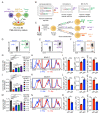An Ex Vivo 3D Tumor Microenvironment-Mimicry Culture to Study TAM Modulation of Cancer Immunotherapy
- PMID: 35563889
- PMCID: PMC9101510
- DOI: 10.3390/cells11091583
An Ex Vivo 3D Tumor Microenvironment-Mimicry Culture to Study TAM Modulation of Cancer Immunotherapy
Abstract
Tumor-associated macrophages (TAMs) accumulate in the solid tumor microenvironment (TME) and have been shown to promote tumor growth and dampen antitumor immune responses. TAM-mediated suppression of T-cell antitumor reactivity is considered to be a major obstacle for many immunotherapies, including immune checkpoint blockade and adoptive T/CAR-T-cell therapies. An ex vivo culture system closely mimicking the TME can greatly facilitate the study of cancer immunotherapies. Here, we report the development of a 3D TME-mimicry culture that is comprised of the three major components of a human TME, including human tumor cells, TAMs, and tumor antigen-specific T cells. This TME-mimicry culture can readout the TAM-mediated suppression of T-cell antitumor reactivity, and therefore can be used to study TAM modulation of T-cell-based cancer immunotherapy. As a proof-of-principle, the studies of a PD-1/PD-L1 blockade therapy and a MAO-A blockade therapy were performed and validated.
Keywords: CAR-engineered T (CAR-T) cell; cancer immunotherapy; checkpoint inhibitor blockade; chimeric antigen receptor (CAR); ex vivo 3D TME-mimicry culture; monoamine oxidase A (MAO-A) blockade; tumor microenvironment (TME); tumor-associated macrophage (TAM).
Conflict of interest statement
L.Y. is a scientific advisor to AlzChem and Amberstone Biosciences, and a co-founder, stockholder, and advisory board member of Appia Bio. None of the declared companies contributed to or directed any of the research reported in this article. The remaining authors declare no competing interest.
Figures





References
Publication types
MeSH terms
Substances
LinkOut - more resources
Full Text Sources
Medical
Research Materials

